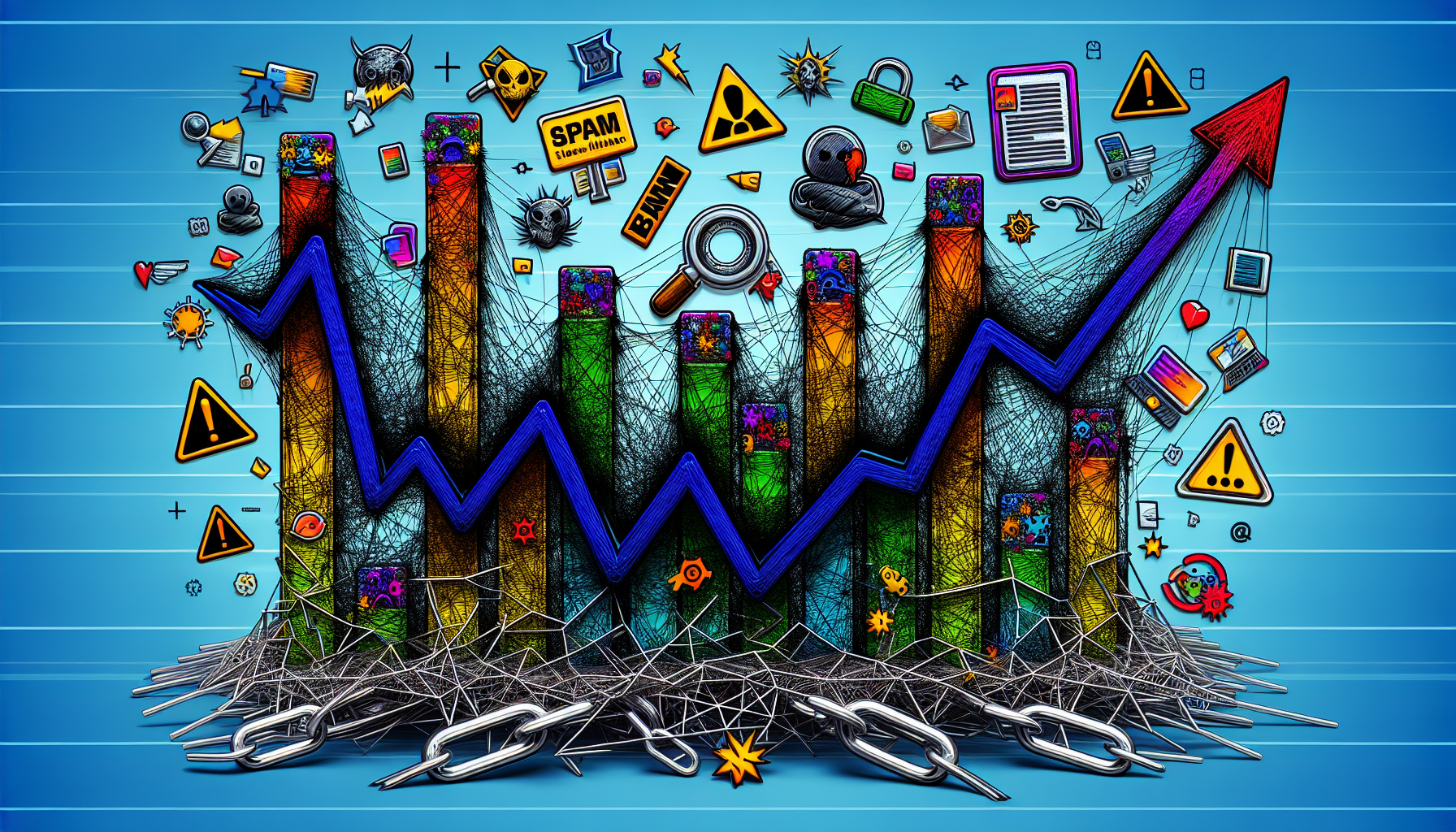As an online marketer, I’ve found that spam websites significantly threaten the integrity and effectiveness of search engine optimization (SEO). These malicious sites can negatively impact website rankings, spread malware, and even lead to blacklisting by search engines.
Understanding how to identify and prevent spam websites from derailing your SEO efforts is crucial in maintaining the health and reputation of your online presence. In this guide, I’ll share essential tips and strategies to help you recognize and combat these harmful sites, protecting your hard-earned SEO successes.
I wrote this article to build upon my previous work on trends in cybersecurity.
Key Takeaways
- Spam websites utilize deceptive tactics to manipulate search engine rankings and can cause significant harm to legitimate sites.
- Identifying spam websites involves analyzing backlink profiles, checking content quality, and monitoring traffic patterns to protect your site’s SEO.
- Preventative measures like regular software updates, strong password policies, and security plugins are essential for safeguarding against spam attacks.
Understanding Spam Websites

Spam websites aim to deceive users and manipulate search engines to achieve higher rankings. These malicious sites are crafted to exploit weaknesses in search engine algorithms, directing traffic to unwanted or harmful destinations. The intent of search engine spam is to manipulate rankings and direct traffic to harmful domains. This manipulation can take many forms, including cloaking, where different content is shown to search engines than to users, and spamdexing, which involves techniques like keyword stuffing to skew search results.
SEO spam involves tactics used by hackers to influence search rankings. Hackers often resort to compromising legitimate websites instead of developing their own. This is because search engines are more likely to ignore obviously scammy websites but might not immediately detect issues on established, legitimate sites, leading to a potential SEO spam infection and attack.
Hacked websites can drive traffic to scams through misleading calls to action and advertisements, causing significant harm to the site’s reputation and user trust.
Common Types of Spam Websites

Spam websites come in various forms, each with unique characteristics and threats. The three most common types are phishing sites, clickbait sites, and ad-heavy sites. Each type impacts search rankings and user experience differently, making it crucial to understand their specific tactics and how they operate.
1. Phishing Sites
Phishing sites are particularly cunning. They disguise themselves as legitimate websites to extract sensitive personal information from users. These sites often mimic the appearance of trusted organizations, like banks or popular online services, to trick users into revealing passwords, credit card details, and other personal identification numbers. Users often realize too late that their sensitive information has been compromised.
The impact of phishing sites extends beyond individual users. When hackers access legitimate websites, they can insert malicious code or links that redirect unsuspecting visitors to phishing pages. This harms the website’s SEO and damages its reputation, as search engines and users alike begin to distrust the compromised site.
The presence of malicious links and spammy content can lead to severe penalties from major search engines, further exacerbating the damage.
2. Clickbait Sites
Clickbait sites employ sensational headlines to lure visitors, promising shocking or sensational content that often falls short of expectations. These sites are designed to maximize click-through rates, prioritizing traffic over content quality. Users quickly realize that the content is superficial or irrelevant, leading to frustration and decreased trust.
Clickbait sites primarily seek advertising revenue generated from high traffic volumes. However, their deceptive nature can lead to negative consequences, such as increased bounce rates and a decline in user trust in online content and search engines.
This type of spam can also manipulate search engine results, further complicating the SEO landscape for legitimate website owners.
3. Ad-heavy Sites
Ad-heavy sites are characterized by overwhelming advertisements, which can significantly degrade the user experience. These sites often contain harmful links disguised as ads, leading users to potentially dangerous destinations. The excessive ads not only frustrate users but can also prompt penalties from search engines, which prioritize user-friendly, high-quality content in their rankings.
Identifying Spam Websites
Identifying spam websites is crucial for maintaining the integrity and ranking of your own website. Google and other major search engines employ both automated systems and manual reviews to detect and combat spam practices. Tools like SEMRush, Ahrefs, and the Akismet plugin are invaluable for spotting SEO spam and monitoring your site’s health.
Multiple scanning methods are available to check your site for spam links and malicious code, ensuring you stay ahead of potential threats.
1. Analyzing Backlink Profiles
Examining your backlink profile is a crucial step in identifying spam websites. Link spam involves creating backlinks solely to artificially boost search engine rankings. Inserting hidden links or masking URLs within web pages is a common tactic used by spammers to manipulate search rankings. Tools like Ahrefs and SEMRush can help you track backlinks and keywords, identifying any unusual patterns that may indicate spam.
Regularly monitoring your link profile for broken or suspicious links can reveal early SEO spam infections. Screaming Frog is particularly useful for this purpose, allowing you to look for broken links and other anomalies.
Maintaining a clean and transparent link profile protects your site from the negative impacts of spammy links and enhances your search engine ranking.
2. Checking Website Content Quality
High-quality website content is crucial for maintaining top search engine rankings. Content optimization is often overlooked in SEO improvements, but it plays an important role in preventing spam infections. Reviewing and updating your site’s content can help eliminate digital clutter and enhance overall performance. Websites should undergo a redesign and cleanup every three to five years to stay relevant and secure.
Manual checks of on-page elements, such as links and content, are essential for identifying potential spam issues. Security plugins can automate these checks and scan for malware and viruses that may result from spam activities.
Security plugins are the quickest way to scan for and remove SEO spam on a WordPress site.
3. Monitoring Traffic Patterns
Regularly monitoring your website’s traffic patterns helps detect potential spam attacks. Unexpected traffic or search rankings changes can be a red flag, indicating that your site may have been targeted by spammers. Early detection of unusual traffic patterns allows for prompt investigation and mitigation, preventing long-term damage to your site’s credibility and performance.
Reviewing your site’s traffic data with tools like Google Analytics helps spot anomalies quickly. By staying vigilant and proactive, you can protect your site from the detrimental effects of SEO spam attacks and maintain a strong search engine presence.
Impact of Spam Websites on Your SEO

Spam websites can have a devastating impact on your SEO efforts. Frequent updates to search engine algorithms are designed to identify and penalize spam tactics, significantly affecting search engine rankings. Spammy content that violates Google’s policies risks being demoted or excluded from search results, leading to a significant drop in website traffic. This can damage businesses that depend on organic search traffic to drive sales and engagement.
Keyword injection and cloaking can undermine user trust and loyalty, impacting your site’s reputation and success. Spam websites can inadvertently damage the reputation of legitimate websites they are associated with, leading to potential penalties from search engines.
Monitoring your site for spammy content and maintaining high-quality standards is crucial for preserving your site’s reputation and search engine ranking.
Protecting Your Site from Spam Websites

Preventing spam attacks is essential for maintaining a secure and trustworthy website. Hackers often manipulate vulnerabilities such as weak passwords, outdated plugins, and a lack of security updates. To protect your site, it’s important to install security plugins, keep all software up to date, and implement strong login security measures.
Utilizing tools like CHEQ Essentials can help safeguard your site against bad traffic and bots, ensuring overall site security.
1. Regular Software Updates
Regularly updating your website’s software and plugins prevents SEO spam infections. It also ensures that security patches are applied, mitigating vulnerabilities that hackers could exploit. It’s essential to stay informed about software releases and promptly update the website’s core, themes, and plugins to defend against security issues.
Outdated software often serves as an entry point for spam attacks. Maintaining a rigorous update schedule can significantly enhance your site’s security and lower the risk of becoming a target for hackers. This is particularly important for small businesses that may not have dedicated IT resources to manage site security.
2. Strong Password Policies
Strong password policies are fundamental for protecting your site from brute-force attacks. Enforcing and regularly updating complex, unique passwords can prevent unauthorized access and enhance overall site security.
This simple yet effective measure is crucial for maintaining the integrity of your website.
3. Utilizing Security Plugins
Security plugins are critical to protect your site from SEO spam and other malicious activities. Plugins like MalCare offer comprehensive solutions, including website application firewalls, malware scanners, and login protection. These features can automate malware removal and enhance site protection, making it easier to maintain a secure website.
Installing a security plugin with a firewall is recommended to prevent future SEO spam attacks. These plugins provide regular scans and automated updates to protect your site against emerging threats.
By leveraging the capabilities of security plugins, you can fortify your site’s defenses and maintain a robust online presence.
Cleaning Up After a Spam Website Attack

Swift action is essential if your website has been compromised by a spam attack. Start by identifying and removing any malicious code or content injected into your site. Restoring your site from a clean backup can significantly speed up this process and ensure that all traces of the malware are eliminated.
After removing spam posts and malicious content, clean up your meta tables and request Google to reindex to restore your search engine ranking.
1. Removing Malicious Code
Carefully scrutinize your site files to remove malicious code from a hacked website. Comparing your current files with known good backups is one of the most effective ways to identify hacked files. Focus on downloading the correct files from official sources and scanning the entire site, especially PHP scripts, for any signs of malware.
It’s crucial to remove any backdoors that hackers may have left to prevent further damage. A trusted security plugin or online scanner can help identify and remove all malicious code.
For WordPress sites, automatic removal with a security plugin is the recommended method for dealing with SEO spam.
2. Rebuilding Credibility
Rebuilding your site’s credibility after a spam attack is crucial for regaining user trust and improving search engine rankings. Implementing a post-hack checklist ensures that all critical areas are addressed, helping to prevent future vulnerabilities.
Constant monitoring and regular updates are vital for maintaining your site’s credibility and protection against further attacks.
3. Requesting Google Reindexing
Request reindexing from Google after cleaning your site to restore its visibility in search results. Navigate to Google Search Console and submit a reindexing request to ensure that your site is re-evaluated and any penalties are lifted.
This step is vital for regaining your site’s search engine ranking and ensuring that your content is accurately represented in search results.
Concluding Remarks
Spam websites pose significant threats to both users and legitimate website owners. Understanding the different types of spam websites, how to identify them, and their impact on SEO is crucial for keeping a secure and reliable online presence. Website owners can protect their sites from spam attacks and maintain high search engine rankings by implementing strong security measures, regularly updating software, and utilizing security plugins.
Taking swift action to clean up after a spam attack and rebuilding credibility are essential steps for recovering from such incidents. Requesting Google reindexing ensures that your site regains its visibility and search engine ranking. Stay vigilant and proactive in your website management to prevent future attacks and maintain a robust SEO presence.
Remember to explore my other articles on emerging technologies in cybersecurity and the statistics of new technologies to deepen your understanding and enhance your site’s defense strategies.
Frequently Asked Questions
1. How can I identify if my website has been compromised by spam?
To determine if your website has been compromised by spam, monitor for sudden traffic changes, check for unusual backlinks, and inspect for spammy content. Utilizing tools such as SEMRush or Ahrefs can assist in identifying these issues effectively.
2. What are the most common types of spam websites?
The most common types of spam websites are phishing sites, clickbait sites, and ad-heavy sites, all of which employ deceptive tactics to mislead users and manipulate search rankings. It’s crucial to be vigilant and avoid these types of sites to protect yourself online.
3. How can I protect my website from spam attacks?
To effectively protect your website from spam attacks, regularly update your software and plugins, enforce strong password policies, and utilize security plugins for scanning and malware removal. Prioritizing these measures is essential for safeguarding your site.
4. What should I do if my website has been attacked by SEO spam?
You must act quickly to remove the malicious content and restore your website using clean backups. Following this, request Google to reindex your site to regain your search engine ranking.
5. How does spam impact my site’s SEO?
Spam negatively impacts your site’s SEO by risking penalties from search engines and lowering your rankings, while also diminishing user trust. Regular monitoring is crucial to safeguard your SEO efforts.



